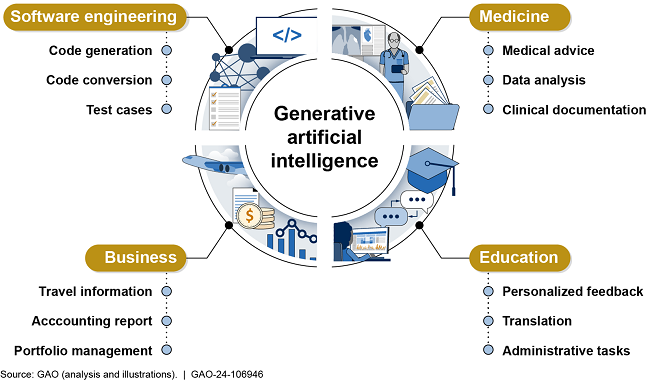Artificial Intelligence: Generative AI Technologies and Their Commercial Applications
Fast Facts
Generative artificial intelligence systems—like ChatGPT and Gemini—create text, images, audio, video, and other content. This Q&A report takes a closer look at the technology behind these increasingly popular systems, and their many uses.
The systems are trained to recognize patterns and relationships in massive datasets and can quickly generate content from the data when prompted by a user. These growing capabilities can be used in health care, education, software engineering, business, and other fields.
But they can also potentially spread disinformation, displace workers, and present national security and environmental risks.

Highlights
What GAO Found
Generative AI can create content such as text, images, audio, or video when prompted by a user. Generative AI differs from other AI systems in its ability to generate novel content, in the vast volumes of data it requires for training, and in the greater size and complexity of its models. Several other notable differences with generative AI models include: the use of natural language for prompts, and increased challenges in understanding and explaining model decisions. Generative AI systems employ several model architectures, or underlying structures. These systems, referred to as neural networks, are modeled loosely on the human brain and recognize patterns in data.
A convergence of factors enabled the rapid development of generative AI: availability of large datasets, refinement and augmentation of deep learning algorithms, and compute capacity. The training of generative AI models requires large amounts of data, much of which are commonly obtained from publicly available information on the internet and which can include copyrighted content. To provide more meaningful and fit-for-purpose responses, commercial developers typically employ a process called reinforcement learning from human feedback. In this process, generative AI models undergo further training where humans evaluate and rank outputs, and then the models imitate the human preferences. Processing the training data and adjusting the increasingly large models require a corresponding compute capacity. Training large generative AI models can take tens of thousands of processors running for months and may cost several hundred million dollars.
Commercial developers have created a wide range of generative AI models that produce text, code, image, and video outputs, as well as products and services that enhance existing products or support customized development and refinement of models to meet customer needs (see fig. below). However, their benefits and risks are still unclear for many applications.
Summary of Potential Applications for Generative Artificial Intelligence

Why GAO Did This Study
For this technology assessment, GAO was asked to describe generative AI and key aspects of its development. This report represents the first installment of a body of work looking at generative AI. In future reports, GAO plans to assess best practices and other factors considered for developing and deploying generative AI tools, societal and environmental effects of the use of generative AI, and federal development and adoption of generative AI technologies.
To conduct this assessment, GAO conducted literature reviews and interviewed representatives from several leading companies developing generative AI technologies. GAO selected these companies based on known information about generative AI technologies they have created and the voluntary commitments they made to the White House to manage risks posed by AI. Through these interviews, GAO gathered information regarding the companies' various models, tools, products, and services that enable the development of generative AI. GAO also reviewed relevant publicly available documentation, such as white papers, model cards, and guidance documents to identify further information regarding the companies' generative AI products.
For more information, contact Brian Bothwell at (202) 512-6888 or bothwellb@gao.gov or Kevin Walsh at (202) 512-6151 or walshk@gao.gov.
